An Underground Adventure at the Field Museum
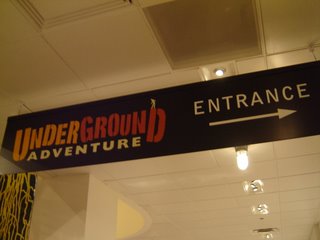 A really neat, kid-friendly exhibit is the Underground Adventure at the Field Museum. It's motto: "there's more to soil than meets the eye." This exhibit tries to make something that is normally as exciting as dirt -- dirt -- actually exciting. It does a great job.
A really neat, kid-friendly exhibit is the Underground Adventure at the Field Museum. It's motto: "there's more to soil than meets the eye." This exhibit tries to make something that is normally as exciting as dirt -- dirt -- actually exciting. It does a great job. To start things off, you enter into a "shrink chamber" making you the size of the soil. A sign says that "all visitors beyond this point will be shrunk to 1/100 of their original size". Neat.
To start things off, you enter into a "shrink chamber" making you the size of the soil. A sign says that "all visitors beyond this point will be shrunk to 1/100 of their original size". Neat. It's a psychedelic experience. It kind of reminded me of the end of 2001: A Space Odyssey.
It's a psychedelic experience. It kind of reminded me of the end of 2001: A Space Odyssey.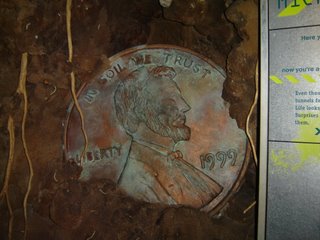 Here's what a penny looks like at our new size. Now imagine how cool that would be if it was chocolate. At this point in the exhibit we become even smaller and we begin to travel under the soil to see what is normally underneath our feet.
Here's what a penny looks like at our new size. Now imagine how cool that would be if it was chocolate. At this point in the exhibit we become even smaller and we begin to travel under the soil to see what is normally underneath our feet. This is an example of zone 2.1, which is abundant with life. A single (real life sized) handful contains as many bacteria as there are people on the entire planet. Thousands of new species are discovered in this area each year.
This is an example of zone 2.1, which is abundant with life. A single (real life sized) handful contains as many bacteria as there are people on the entire planet. Thousands of new species are discovered in this area each year.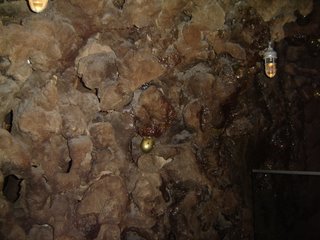 We move down further to zone 7.1 (I'm not sure what these numbers mean). Here, roots grow by pushing their way through soil. Roots sometimes follow the paths made by other animals. Here, soil particles stick together in the form of aggregates, or clumps. This allows for space for air and water, things vital for life that grows in the soil.
We move down further to zone 7.1 (I'm not sure what these numbers mean). Here, roots grow by pushing their way through soil. Roots sometimes follow the paths made by other animals. Here, soil particles stick together in the form of aggregates, or clumps. This allows for space for air and water, things vital for life that grows in the soil. In zone 9.1, things get a little weird. Crayfish, for example, breath oxygen through their gills in water. When in the soil, they burrow down looking for water pockets to do so.
In zone 9.1, things get a little weird. Crayfish, for example, breath oxygen through their gills in water. When in the soil, they burrow down looking for water pockets to do so.Here, dead plants and animals serve as nutrients for the soil. Fungi, bacteria and other decomposers cause dead things to decay, and they return the nutrients to the soil. They are recycling machines. Without these decomposers, the building blocks of our food chain would quickly die and we'd run out of food quickly.
 It was time for us to return to normal size and look at the dirt as we know it in regular size.
It was time for us to return to normal size and look at the dirt as we know it in regular size.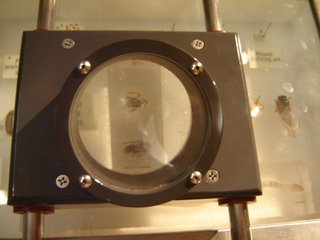 At our normal size, we need magnifying glasses to see bugs up close.
At our normal size, we need magnifying glasses to see bugs up close. This Berlese funnel is what scientists use to capture plants and animals in the soil. Light is used to scare away living things and convince them to go into our containers. Ha! The fools!
This Berlese funnel is what scientists use to capture plants and animals in the soil. Light is used to scare away living things and convince them to go into our containers. Ha! The fools! Beetles look much better in glass containers than in real life.
Beetles look much better in glass containers than in real life. Sand, silt, and clay, the building blocks of most of our rocks, are on display. The variety of the size of these grains in a particular place has a lot to do with what can grow and the things that can live underground. Air and space are needed for most living things in soil.
Sand, silt, and clay, the building blocks of most of our rocks, are on display. The variety of the size of these grains in a particular place has a lot to do with what can grow and the things that can live underground. Air and space are needed for most living things in soil.Man's effect on our soil is demonstrated. When building a house, for instance, topsoil is often scraped away. When construction is over, it is often replaced but construction packs it in too tightly. It means that there is no longer any room for the air and water normally held in the soil, which prevents plants and other living things to survive. The right sized pores are vital when keeping things alive.
 Ideal soil is half-and-half -- half spaces and half solids. Over 90% of the solids consist of ground-up and weathered bits of rock, according to the sign above.
Ideal soil is half-and-half -- half spaces and half solids. Over 90% of the solids consist of ground-up and weathered bits of rock, according to the sign above.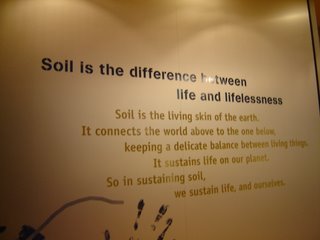 It was amazing, but the Field Museum did manage to make dirt interesting. "Soil is the difference between life and lifelessness," the sign says. It's yet another thing I'll have to worry about now.
It was amazing, but the Field Museum did manage to make dirt interesting. "Soil is the difference between life and lifelessness," the sign says. It's yet another thing I'll have to worry about now.RELATED LINKS:
The Field Museum (General Exhibits)

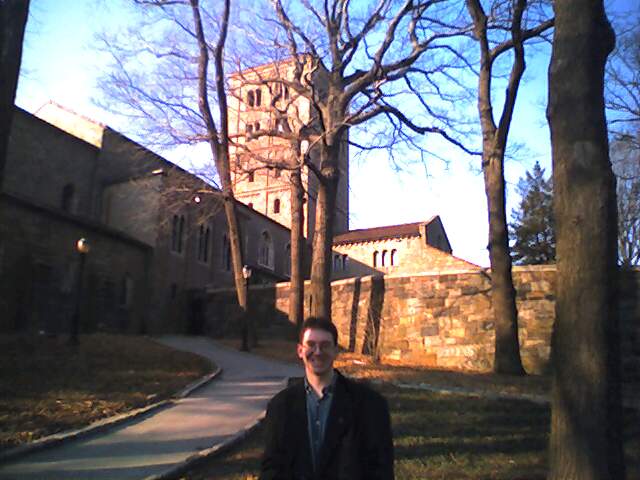

0 Comments:
Post a Comment
|<< Home